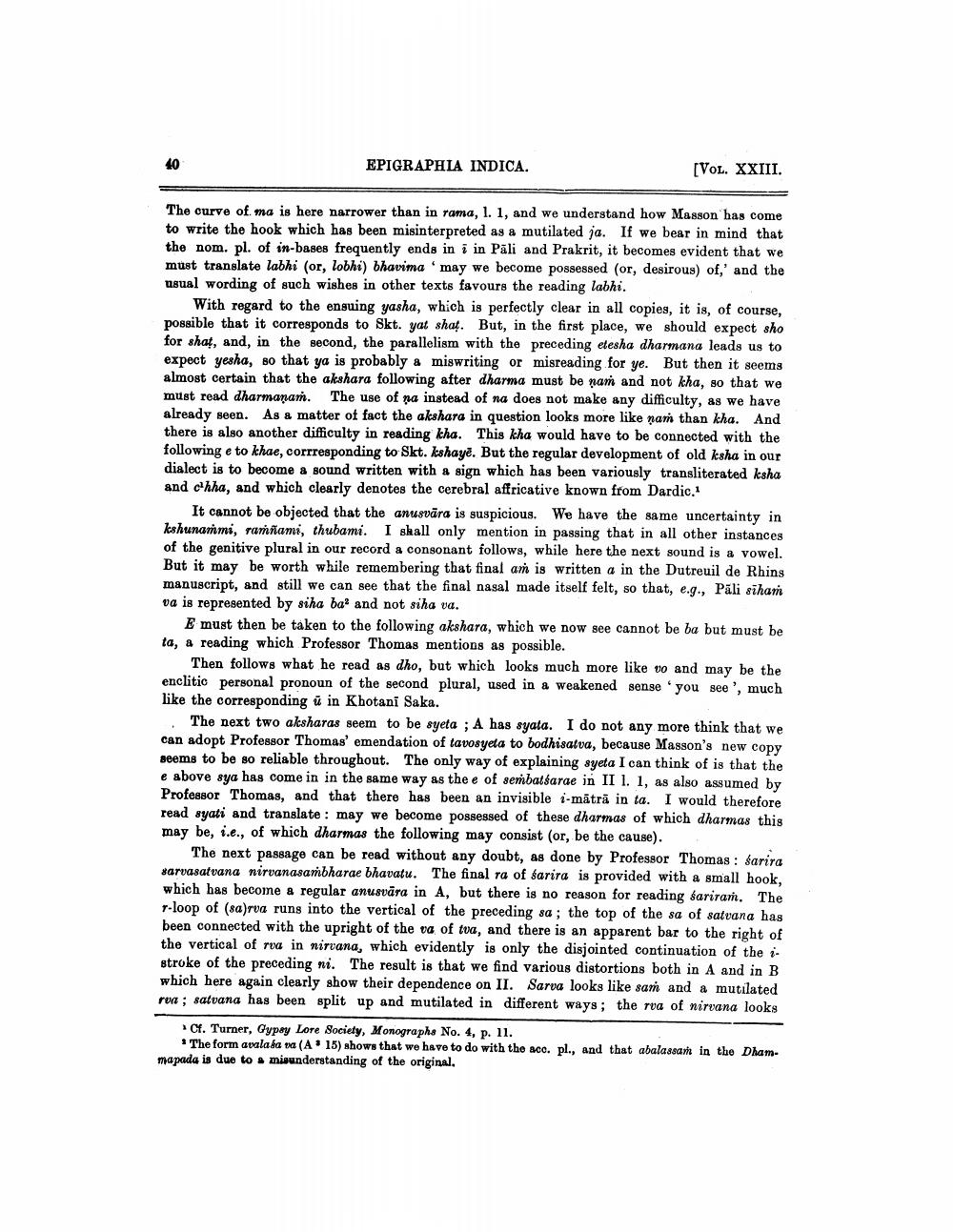________________
40
EPIGRAPHIA INDICA.
[VOL. XXIII.
The curve of ma is here narrower than in rama, 1. 1, and we understand how Masson has come to write the hook which has been misinterpreted as a mutilated ja. If we bear in mind that the nom. pl. of in-bases frequently ends in i in Päli and Prakrit, it becomes evident that we must translate labhi (or, lobhi) bhavima may we become possessed (or, desirous) of,' and the usual wording of such wishes in other texts favours the reading labhi.
With regard to the ensuing yasha, which is perfectly clear in all copies, it is, of course, possible that it corresponds to Skt. yat shat. But, in the first place, we should expect sho for shat, and, in the second, the parallelism with the preceding etesha dharmana leads us to expect yesha, so that ya is probably a miswriting or misreading for ye. But then it seems almost certain that the akshara following after dharma must be nam and not kha, so that we must read dharmanam. The use of na instead of na does not make any difficulty, as we have already seen. As a matter of fact the akshara in question looks more like nam than kha. And there is also another difficulty in reading kha. This kha would have to be connected with the following e to khae, corrresponding to Skt. kshaye. But the regular development of old ksha in our dialect is to become a sound written with a sign which has been variously transliterated ksha and chha, and which clearly denotes the cerebral affricative known from Dardic.1
It cannot be objected that the anusvära is suspicious. We have the same uncertainty in kshunammi, ramñami, thubami. I shall only mention in passing that in all other instances of the genitive plural in our record a consonant follows, while here the next sound is a vowel. But it may be worth while remembering that final am is written a in the Dutreuil de Rhins manuscript, and still we can see that the final nasal made itself felt, so that, e.g., Päli siham va is represented by siha ba and not siha va.
E must then be taken to the following akshara, which we now see cannot be ba but must be ta, a reading which Professor Thomas mentions as possible.
Then follows what he read as dho, but which looks much more like vo and may be the enclitic personal pronoun of the second plural, used in a weakened sense you see, much like the corresponding u in Khotani Saka.
The next two aksharas seem to be syeta; A has syata. I do not any more think that we can adopt Professor Thomas' emendation of tavosyeta to bodhisatva, because Masson's new copy seems to be so reliable throughout. The only way of explaining syeta I can think of is that the e above sya has come in in the same way as the e of sembatsarae in II 1. 1, as also assumed by Professor Thomas, and that there has been an invisible i-matra in ta. I would therefore read syati and translate: may we become possessed of these dharmas of which dharmas this may be, i.e., of which dharmas the following may consist (or, be the cause).
The next passage can be read without any doubt, as done by Professor Thomas: sarira sarvasatvana nirvanasambharae bhavatu. The final ra of sarira is provided with a small hook, which has become a regular anusvära in A, but there is no reason for reading sariram. The r-loop of (sa)rva runs into the vertical of the preceding sa; the top of the sa of satvana has been connected with the upright of the va of tva, and there is an apparent bar to the right of the vertical of rea in nirvana, which evidently is only the disjointed continuation of the istroke of the preceding ni. The result is that we find various distortions both in A and in B which here again clearly show their dependence on II. Sarva looks like sam and a mutilated rea; satvana has been split up and mutilated in different ways; the rea of nirvana looks
Cf. Turner, Gypsy Lore Society, Monographs No. 4, p. 11.
The form avalasa va (A 15) shows that we have to do with the acc. pl., and that abalassam in the Dhammapada is due to a misunderstanding of the original.




